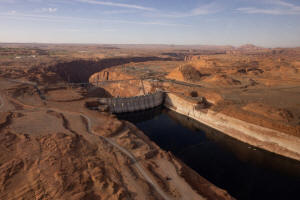U.S. warns western states it may impose Colorado River water cuts
 Send a link to a friend
Send a link to a friend
 [October 29, 2022]
By Daniel Trotta [October 29, 2022]
By Daniel Trotta
(Reuters) - The U.S. government warned on
Friday that it may impose water supply cuts on California, Arizona and
Nevada to protect the Colorado River and its two main reservoirs from
overuse, drought and climate change.
The U.S. Bureau of Reclamation unveiled three possible action plans: one
to impose cutbacks, another to allow western states to work out a
reduction plan on their own, or a third and least likely option of
taking no action.
Besides protecting drinking water supplies, the proposed federal action
might also preserve hydroelectric production at the country's two
largest reservoirs.
The bureau, part of the Department of Interior, had previously set a
mid-August deadline for seven western states to negotiate their own
reductions or possibly face mandatory cutbacks.
When the deadline passed, federal officials gave the states more time to
reach a deal affecting the water supply of 40 million people. While
federal officials still prefer a negotiated settlement, that time
appears to be running out, as the bureau said it would stop hearing
public comments on the proposals on Dec. 20.

"We are committed to taking prompt and decisive action necessary to
protect the Colorado River System and all those who depend on it,"
Interior Secretary Deb Haaland said in a press statement.
The seven states operate under a 100-year-old compact distributing
Colorado River water, but that agreement has come under increasing
strain from the worst drought in 1,200 years, which has been exacerbated
by climate change.
[to top of second column]
|

An aerial view of Lake Powell is seen,
where water levels have declined dramatically to lows not seen since
it was filled in the 1960s as growing demand for water and climate
change shrink the Colorado River and create challenges for business
owners and recreation in Page, Arizona, U.S., April 20, 2022.
REUTERS/Caitlin Ochs/

A century ago, the compact assumed the river could provide 20 million
acre-feet of water each year. The river's actual flow the past two
decades has averaged 12.5 million acre-feet, leaving state water
managers with more rights on paper than water that exists in the river.
Friday's notice said that among the cutback options being considered
was decreasing the amount of water set aside for consumption in the
2023/24 water year by the three states of the so-called Lower Basin:
California, Arizona and Nevada.
The Upper Basin states of Colorado, New Mexico, Utah and Wyoming
would be spared for now, but are still being asked to participate in
negotiations to cut usage by an unprecedented 15% to 30%.
Other possible measures include modifying operations at Hoover Dam,
which forms the country's largest reservoir of Lake Mead, and
reducing the amount of water released from Glen Canyon Dam, which
forms Lake Powell, the second-largest reservoir.
Lake Mead was at 29% of capacity on Friday and Lake Powell 24%. If
they fall much lower, they will be unable to generate hydroelectric
power for millions in the west.
(Reporting by Daniel Trotta; Editing by Josie Kao)
[© 2022 Thomson Reuters. All rights
reserved.]
This material may not be published,
broadcast, rewritten or redistributed.
Thompson Reuters is solely responsible for this content. |